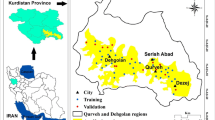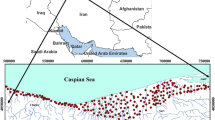Abstract
Regarding the ever increasing issue of water scarcity in different countries, the current study plans to apply support vector machine (SVM), random forest (RF), and genetic algorithm optimized random forest (RFGA) methods to assess groundwater potential by spring locations. To this end, 14 effective variables including DEM-derived, river-based, fault-based, land use, and lithology factors were provided. Of 842 spring locations found, 70% (589) were implemented for model training, and the rest of them were used to evaluate the models. The mentioned models were run and groundwater potential maps (GPMs) were produced. At last, receiver operating characteristics (ROC) curve was plotted to evaluate the efficiency of the methods. The results of the current study denoted that RFGA, and RF methods had better efficacy than different kernels of SVM model. Area under curve (AUC) of ROC value for RF and RFGA was estimated as 84.6, and 85.6%, respectively. AUC of ROC was computed as SVM- linear (78.6%), SVM-polynomial (76.8%), SVM-sigmoid (77.1%), and SVM- radial based function (77%). Furthermore, the results represented higher importance of altitude, TWI, and slope angle in groundwater assessment. The methodology created in the current study could be transferred to other places with water scarcity issues for groundwater potential assessment and management.







Similar content being viewed by others
References
Breiman L (2001) Random forests. Mach Learn 45:5–32
Brenning A (2005) Spatial prediction models for landslide hazards: review, comparison and evaluation. Nat. Hazard. Earth Syst 5:853–862
Catani F, Lagomarsino D, Segoni S, Tofani V (2013) Landslide susceptibility estimation by random forests technique: sensitivity and scaling issues. Nat Hazards Earth Syst Sci 13:2815–2831
Chang CL, Lo SL, Yu SL (2006) The parameter optimization in the inverse distance method by genetic algorithm for estimating precipitation. Environ Monit Assess 117:145–155
Chen YR, Chen JW, Hsieh SC, Ni PN (2009) The application of remote sensing technology to the interpretation of land use for rainfall-induced landslides based on genetic algorithms and artificial neural networks. IEEE Journal of Selected Topics in Applied Earth Observations and Remote Sensing 2:87–95
Davoodi Moghaddam D, Rezaei M, Pourghasemi HR, Pourtaghie ZS, Pradhan B (2015) Groundwater spring potential mapping using bivariate statistical model and GIS in the Taleghan watershed, Iran. Arab J Geosci 8(2):913–929
Elmahdy SI, Mostafa Mohamed M (2014) Groundwater potential model- ling using remote sensing and GIS: a case study of the al Dhaid area, United Arab Emirates. Geocarto Intern 29(4):433–450
Geology Survey of Iran (GSI) (1997) Geology map of the Chaharmahal-e-Bakhtiari Province. http://www.gsi.ir/Main/ Lang_en/index.html. Accessed September 2000
Hasegawa H, Arimura M, Tamura T (2006) Hybrid Model of Random Forests and Genetic Algorithms for Commute Mode Choice Analysis, 9
Kavzoglu T, Sahin EK, Colkesen I (2013) Landslide susceptibility mapping using GIS-based multi-criteria decision analysis, support vector machines, and logistic regression. Landslides 11(3): 425–439
Lee S, Song K-Y, Kim Y, Park I (2012) Regional groundwater productivity potential mapping using a geographic information system (GIS) based artificial neural network model. Hydrogeol J 20:1511–1527
Liaw A, Wiener M, (2002) Classification and regression by random forest. R News 2: 18–22
Marjanovic M, Bajat B, Kovacevic M (2009) Landslide susceptibility assessment with machine learning algorithms. 2009 international conference on intelligent networking and collaborative systems, (august) 273–278. doi:10.1109/INCOS.2009.25
Mebane WRJ, Sekhon JS (2011) Genetic optimization using derivatives: the rgenoud package for R. J Stat Softw 42(11)
Mogaji KA, Omosuyi GO, Adelusi AO, Lim HS (2016) Application of GIS-based evidential belief function model to regional groundwater recharge potential zones mapping in Hardrock geologic terrain. Environ Process 3(1):93–123. doi:10.1007/s40710-016-0126-6
Moisen GG, Freeman EA, Blackard JA, Frescino TS, Zimmermann NE, Edwards TC (2006) Predicting tree species presence and basal area in Utah: a comparison of stochastic gradient boosting, generalized additive models, and tree-based methods. Ecol Model 199(2):176–187. doi:10.1016/j.ecolmodel.2006.05.021
Moore ID, Grayson RB, Ladson AR (1991) Digital terrain modelling: a review of hydrological, geomorphological, and biological applications. Hydrol Process 5:3–30
Naghibi SA, Pourghasemi HR (2015) A comparative assessment between three machine learning models and their performance comparison by bivariate and multivariate statistical methods in groundwater potential mapping. Water Resour Manag. doi:10.1007/s11269-015-1114-8
Naghibi SA, Pourghasemi HR, Pourtaghi ZS, Rezaei A (2014) Groundwater qanat potential mapping using frequency ratio and Shannon’s entropy models in the Moghan watershed, Iran. Earth Sci Inf 8(1):171–186. doi:10.1007/s12145-014-0145-7
Naghibi SA, Moghaddam DD, Kalantar B, Pradhan B, Kis O (2017) A comparative assessment of GIS-based data mining models and a novel ensemble model in groundwater well potential mapping. J Hydrol. doi:10.1016/j.jhydrol.2017.03.020
Negnevitsky M (2002) Artificial intelligence: a guide to intelligent systems. Pearson, Harlow, UK, 394 pp
Oh HJ, Kim YS, Choi JK, Park E, Lee S (2011) GIS mapping of regional probabilistic groundwater potential in the area of Pohang City, Korea. J Hydrol 399:158–172
Ozdemir A (2011a) GIS-based groundwater spring potential mapping in the SultanMountains (Konya, Turkey) using frequency ratio, weights of evidence and logistic regression methods and their comparison. J Hydrol 411:290–308
Ozdemir A (2011b) Using a binary logistic regression method and GIS for evaluating and mapping the groundwater spring potential in the Sultan Mountains (Aksehir, Turkey). J Hydrol 405:123–136
Pourtaghi ZS, Pourghasemi HR (2014) GIS-based groundwater spring potential assessment and mapping in the Birjand township. Southern Khorasan Province Iran Hydrogeol J. doi:10.1007/s10040-013- 1089-6
Pradhan B (2013) A comparative study on the predictive ability of the decision tree, support vector machine and neuro-fuzzy models in landslide susceptibility mapping using GIS. Comput Geosci 51:350–365
R Development Core Team (2008) R: A Language and Environment for Statistical Computing. R Foundation for Statistical Computing, Vienna, Austria ISBN 3–900051–07-0
Rahmati O, Pourghasemi HR, Melesse AM (2016) Application of GIS-based data driven random forest and maximum entropy models for groundwater potential mapping: a case study at Mehran region, Iran. Catena 137:360–372. doi:10.1016/j.catena.2015.10.010
Rekha VB, Thomas AP (2007) Integrated remote sensing and GIS for groundwater potentially mapping in Koduvan Àr-sub-watershed of Meenachil river basin, Kottayam District. School of environmental sciences Mahatma Gandhi University, Kerala, Kerala
Tabassum M, Mathew K (2014) A genetic algorithm analysis towards optimization solutions. Intern J Digit Info Wireless Comm (IJDIWC) 4(1):124–142 Retrieved from http://sdiwc.net/digital-library/a-genetic-algorithm-analysis-towards-optimization-solutions.html
Tehrany MS, Pradhan B, Jebur MN (2014) Flood susceptibility mapping using a novel ensemble weights-of-evidence and support vector machine models in GIS. Journal of hydrology, 512(MAY):332–343. doi:10.1016/j.jhydrol.2014.03.008
Tehrany MS, Pradhan B, Mansor S, Ahmad N (2015) Flood susceptibility assessment using GIS-based support vector machine model with different kernel types. Catena 125:91–101. doi:10.1016/j.catena.2014.10.017
Termansen M, McClean CJ, Preston CD (2006) The use of genetic algorithms and Bayesian classification to model species distributions. Ecol Model 192:410–424
Theodossiou N (2016) Assessing the impacts of climate change on the sustainability of groundwater aquifers. Application in Moudania aquifer in N. Greece Environ Process 3(4):1045–1061. doi:10.1007/s40710-016-0191-x
Thivya C, Chidambaram S, Rao MS, Gopalakrishnan M, Thilagavathi R, Prasanna MV, Nepolian M (2016) Identification of recharge Processes in groundwater in hard rock aquifers of Madurai District using stable isotopes. Environ Process 3(2):463–477. doi:10.1007/s40710-016-0137-3
Tien Bui D, Pradhan B, Lofman O, Revhaug I (2012) Landslide susceptibility assessment in vietnam using support vector machines, decision tree, and naive bayes models. Math Probl Eng. doi:10.1155/2012/974638
Tien Bui D, Tuan TA, Klempe H, Pradhan B, Revhaug I (2015) Spatial prediction models for shallow landslide hazards: a comparative assessment of the efficacy of support vector machines, artificial neural networks, kernel logistic regression, and logistic model tree. Landslides. doi:10.1007/s10346-015-0557-6
Todd DK, Mays LW (2005) Groundwater hydrology. Wiley, New York
Yao X, Tham LG, Dai FC (2008) Landslide susceptibility mapping based on support vector machine: a case study on natural slopes of Hong Kong, China. Geomorphology 101:572–582
Yilmaz I (2010) Comparison of landslide susceptibility mapping methodologies for Koyulhisar, Turkey: conditional probability, logistic regression, artificial neural networks, and support vector machine. Environ Earth Sci 61:821–836
Zhuang L, Dai H (2006) Parameter optimization of kernel-based one-class classifier on imbalance learning. J Comput Secur 1:32–40
Author information
Authors and Affiliations
Corresponding author
Rights and permissions
About this article
Cite this article
Naghibi, S.A., Ahmadi, K. & Daneshi, A. Application of Support Vector Machine, Random Forest, and Genetic Algorithm Optimized Random Forest Models in Groundwater Potential Mapping. Water Resour Manage 31, 2761–2775 (2017). https://doi.org/10.1007/s11269-017-1660-3
Received:
Accepted:
Published:
Issue Date:
DOI: https://doi.org/10.1007/s11269-017-1660-3




